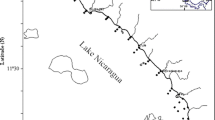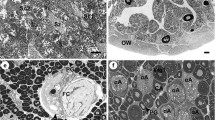Abstract
Since the 1950’s the population structure of the Atlantic menhaden,Brevoortia tyrannus, has undergone dramatic changes. High rates of fishery exploitation during the 1960’s resulted in a drastic decline in the breadth of the age structure and numbers of spawning aged fish. The stock recovered under continued exploitation during the 1970’s in spite of these unfavorable conditions. Hence, the length and age at first spawning, the seasons and areas of spawning, and the potential number of ova produced as a function of length were reexamined during the 1978, 1979, and 1981 fishing seasons. No changes were detected in the reproductive biology of Atlantic menhaden. The size at first spawning, areas, and season of spawning were similar to results of previous studies. The minimum fork length of potential spawners was 180 mm. Few age-1 fish were mature but most females were mature at age-2. Analysis of the ovaries collected along the coast indicated some spawning occurred in the spring, a limited amount occurred in the summer, and most spawning occurred during the fall and winter. There was high intra-and interyear variability in the relationship between length and potential number of ova produced, and regression coefficients encompassed values from two previous studies, each based on a single fishing year. Data from this and the previous studies were combined and equally weighted to generate a representative predictive equation for the potential number of ova spawned as a function of length: eggs = 2563e0.0150(FL).
Similar content being viewed by others
Literature Cited
Ahrenholz, D. W., W. R. Nelson, andS. P. Epperly. 1987. Population and fishery characteristics of Atlantic menhaden,Brevoortia tyrannus.US Nat. Mar. Fish. Serv. Fish. Bull. 85:569–600.
Atlantic States Marine Fisheries Commission. 1981. Fishery management plan for Atlantic menhaden. Atl. States Mar. Fish. Comm., Fish. Manage. Rep. No. 2. 134 p.
Bagenal, T. B., andE. Braum. 1978. Eggs and early life history, p. 165–201.In T. Bagenal (ed.), Methods for Assessment of Fish Production in Fresh Waters, 3rd ed. IBP (Int. Biol. Programme) Hando. 3. Blackwell Scientific, Oxford.
Bigelow, H. B., andW. C. Schroeder. 1953. Fishes of the Gulf of Maine.US Fish. Wildl. Serv. Fish. Bull. 53:1–577.
Chester, A. J. 1984. Sampling statistics in the Atlantic menhaden fishery. US Dep. Commer., NOAA Tech. Rep. NMFS 9. 16 p.
Conover, D. O. 1985. Field and laboratory assessment of pattern in fecundity of a multiple spawning fish: The Atlantic silversideMenidia menidia.US Natl. Mar. Fish. Serv. Fish. Bull. 83:331–341.
Dietrich, C. S., Jr. 1979. Fecundity of Atlantic menhaden,Brevoortia tyrannus.US Natl. Mar. Fish. Serv. Fish. Bull. 77: 308–311.
Higham, J. R., andW. R. Nicholson. 1964. Sexual maturation and spawning of Atlantic menhaden.US Fish. Wildl. Serv. Fish. Bull. 63:255–271.
Judy, M. H., and R. M. Lewis. 1983. Distribution of eggs and larvae of Atlantic menhaden,Brevoortia tyrannus, along the Atlantic coast of the United States. US Dep. Commer., Natl. Mar. Fish. Serv. Spec. Sci. Rep. Fish. 774. 23 p.
June, F. C., and J. W. Reintjes. 1959. Age and size composition of the menhaden catch along the Atlantic coast of the United States, 1952–1955; with a brief review of the commercial fishery. US Fish Wildl. Serv. Spec. Sci. Rep. Fish. No. 317. 65 p.
Kendall, A. W., Jr., andJ. W. Reintjes. 1975. Geographic and hydrographic distribution of Atlantic menhaden eggs and larvae along the middle Atlantic coast from RVDolphin cruises, 1965–66.US Natl. Mar. Fish. Serv. Fish. Bull. 73:317–335.
Marquardt, D. W. 1963. An algorithm for least-squares estimation of nonlinear parameters.J. Soc. Ind. appl. Math. 11: 431–441.
Massmann, W. H., J. J. Norcross, andEdwin B. Joseph. 1962. Atlantic menhaden larvae in Virginia coastal waters.Chesapeake Sci. 3:42–45.
Nicholson, W. R. 1972. Population structure and movements of Atlantic menhaden,Brevoortia tyrannus, as inferred from back-calculated length frequencies.Chesapeake Sci. 13:161–174.
Reintjes, J. W. 1961. Menhaden eggs and larvae from M/VTheodore N. Gill cruises, south Atlantic coast of the United States, 1953–1954. US Fish Wildl. Serv. Spec. Sci. Rep. Fish. No. 393. 7 p.
Author information
Authors and Affiliations
Rights and permissions
About this article
Cite this article
Lewis, R.M., Ahrenholz, D.W. & Epperly, S.P. Fecundity of Atlantic menhaden,Brevoortia tyrannus . Estuaries 10, 347–350 (1987). https://doi.org/10.2307/1351894
Received:
Accepted:
Issue Date:
DOI: https://doi.org/10.2307/1351894




